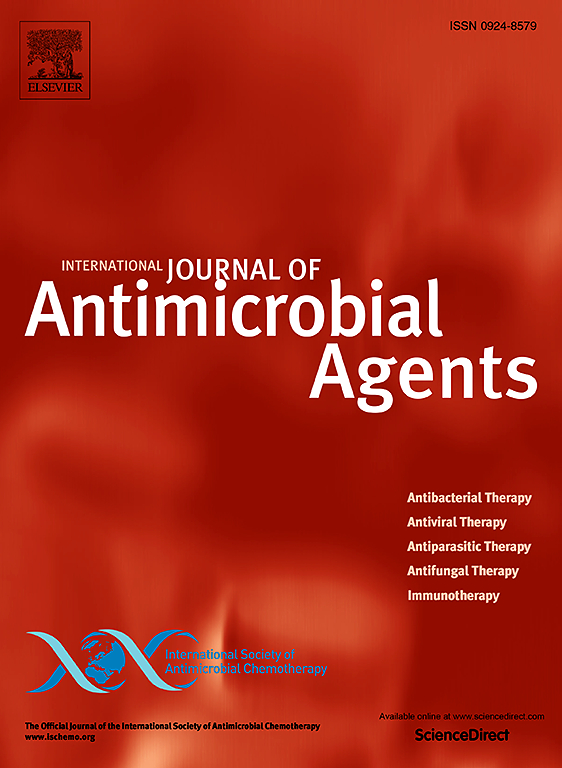Development and validation of a time-varying correction factor for QT interval assessment in drug-resistant tuberculosis patients
IF 4.9
2区 医学
Q1 INFECTIOUS DISEASES
International Journal of Antimicrobial Agents
Pub Date : 2025-02-06
DOI:10.1016/j.ijantimicag.2025.107460
引用次数: 0
Abstract
Background
Tachycardia associated with active tuberculosis (TB) often diminishes when patients recover from TB. Elevated heart rate (HR) may lead to suboptimal correction, complicating the assessment of QT prolongation when using standard correction factors (CFs), such as Fridericia's formula (QTcF). Olliaro has proposed a CF for QT interval correction in pretreatment TB patients. However, the QT-HR correlation changes as HR decreases during treatment, indicating the need for time-varying correction.
Methods
We developed an HR model to capture the HR normalisation during successful treatment. Subsequently, a time-varying CF was constructed using the estimated HR change rate. The performance of CFs to make corrected QT (QTc) independent from HR was evaluated by linear regression analyses of QTc versus HR within defined time bins.
Results
The final HR model included asymptotic change in HR attributed to time on treatment, circadian rhythm cycles, M2 (bedaquiline-metabolite) concentration, and patient covariates. The time-varying CF decreased from 0.4081 to 0.33, with a half-life of 7.74 weeks. The slope (QTc/HR vs. Time) derived from the time-varying correction was not significantly different from 0 (95% CI –0.003 to 0.002), and the intercept was not significantly different from 0 (95% CI –0.089 to 0.006), demonstrating successful QT correction from pretreatment to the end of treatment.
Conclusion
The time-varying CF effectively captures the dynamic QT-HR relationship during TB treatment, reducing the risk of misdiagnosing QT prolongation or unnecessary discontinuation of treatment. By addressing underestimation and overestimation issues in QT interval assessment, this method enhances drug evaluation in clinical trials and supports improved treatment decisions for TB patients.
耐药结核患者QT间期评估时变校正因子的开发与验证。
背景:与活动性结核病(TB)相关的心动过速通常在结核病患者康复后减少。心率(HR)升高可能导致次优校正,使使用标准校正因子(cf)(如Fridericia公式(QTcF))时QT延长的评估复杂化。Olliaro提出CF用于治疗前结核患者的QT间期矫正。然而,QT-HR相关性随着治疗过程中HR的降低而变化,表明需要进行时变校正。方法:我们开发了一个HR模型来捕捉成功治疗期间的HR归一化。随后,利用估计的HR变化率构建时变CF。在定义的时间内,通过QTc与HR的线性回归分析来评估cf使校正QT (QTc)独立于HR的性能。结果:最终的HR模型包括治疗时间、昼夜节律周期、M2(贝达喹啉代谢物)浓度和患者协变量导致的HR渐进变化。时变CF由0.4081降至0.33,半衰期为7.74周。由时变校正得出的斜率(QTc/HR vs. Time)在0范围内无显著差异(95%CI -0.003 ~ 0.002),截距在0范围内无显著差异(95%CI -0.089 ~ 0.006),表明从治疗前到治疗结束QT校正成功。结论:时变CF可有效捕捉结核治疗过程中QT- hr的动态关系,降低误诊QT延长或不必要停药的风险。通过解决QT间期评估中的低估和高估问题,该方法增强了临床试验中的药物评估,并支持改进结核病患者的治疗决策。
本文章由计算机程序翻译,如有差异,请以英文原文为准。
求助全文
约1分钟内获得全文
求助全文
来源期刊
CiteScore
21.60
自引率
0.90%
发文量
176
审稿时长
36 days
期刊介绍:
The International Journal of Antimicrobial Agents is a peer-reviewed publication offering comprehensive and current reference information on the physical, pharmacological, in vitro, and clinical properties of individual antimicrobial agents, covering antiviral, antiparasitic, antibacterial, and antifungal agents. The journal not only communicates new trends and developments through authoritative review articles but also addresses the critical issue of antimicrobial resistance, both in hospital and community settings. Published content includes solicited reviews by leading experts and high-quality original research papers in the specified fields.

 求助内容:
求助内容: 应助结果提醒方式:
应助结果提醒方式:


